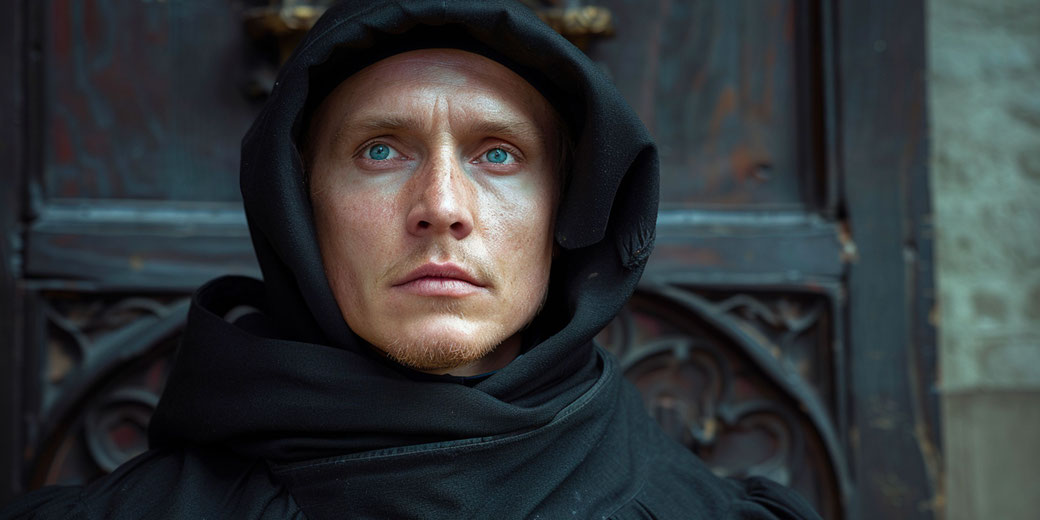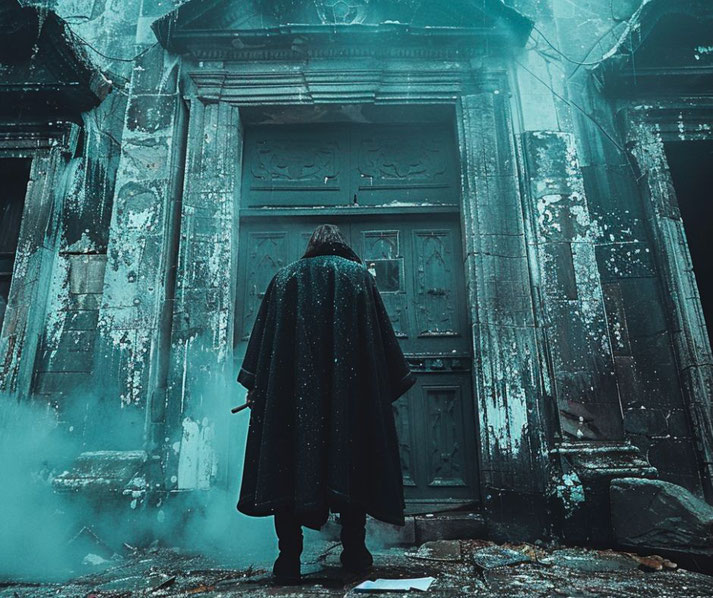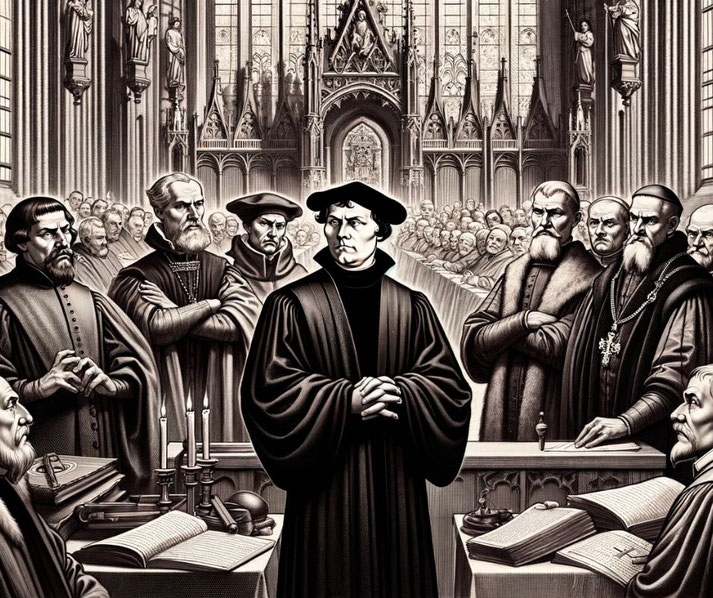How Martin Luther challenged the might of the Catholic Church

In a world where religious authority went unchallenged, Martin Luther emerged as a daring voice of dissent. His audacious act of nailing the 95 Theses to the door of the Castle Church in Wittenberg ignited a firestorm that would forever alter the landscape of Christianity.
Luther's bold critique of the Catholic Church's practices, particularly the sale of indulgences, set him on a collision course with the most powerful institution of his time.
As he translated the Bible into the language of the people and championed the principle of salvation by faith alone, Luther changed the course of history itself.
Martin Luther's early life
Martin Luther was born on November 10, 1483, in Eisleben, Saxony, in what is now Germany.
His father, Hans Luther, was a miner and later a smelter owner, while his mother, Margarethe, came from a small but respectable family.
Determined to see his son rise above the life of a miner, Hans Luther planned for Martin to become a lawyer.
Martin began his education at a local school in Mansfeld, where he learned reading, writing, and Latin.
In 1497, he was sent to Magdeburg to attend a school run by the Brethren of the Common Life, a lay religious order that emphasized piety and simplicity.
After a year in Magdeburg, Luther moved to Eisenach to continue his studies.
In 1501, at the age of 17, he enrolled at the University of Erfurt, one of the leading universities in Germany at the time.
He received his Bachelor's degree in 1502 and his Master's degree in 1505, excelling in his studies of the liberal arts.
However, Luther's life took a dramatic turn in July 1505 when, during a thunderstorm, he was nearly struck by lightning.
Terrified, he vowed to become a monk if he survived, a promise he fulfilled by entering the Augustinian monastery in Erfurt just two weeks later.
Luther's decision to become a monk marked the beginning of his theological education.
He was ordained as a priest in 1507 and began to study theology at the University of Erfurt.
In 1508, he was sent to the newly founded University of Wittenberg to teach theology.
Why did Martin Luther challenge the Church?
Martin Luther's growing disillusionment with the Catholic Church reached a tipping point in 1517, triggered by the widespread sale of indulgences.
Indulgences were certificates sold by the Church that purported to reduce the time souls spent in purgatory for their sins.
Johann Tetzel, a Dominican friar, was famously selling indulgences near Wittenberg to fund the construction of St. Peter's Basilica in Rome.
Luther was appalled by the practice, viewing it as a corrupt exploitation of the faithful's fear and ignorance.
On October 31, 1517, Luther took a decisive stand against this abuse by posting his 95 Theses on the door of the Castle Church in Wittenberg.
This act was not initially intended as a challenge to the Church's authority but as an invitation to an academic debate on the theology and efficacy of indulgences.
However, the theses quickly spread throughout Germany and beyond, thanks to the recent invention of the printing press.

In his theses, Luther argued that salvation could not be bought but was a gift from God, received through faith.
He criticized the pope's role in the sale of indulgences, asserting that the pope had no power to release souls from purgatory.
Luther's critique extended beyond indulgences to other church practices he found unbiblical, such as the emphasis on relics and pilgrimages.
How did the Church respond to Luther?
The controversy surrounding Martin Luther's 95 Theses and subsequent writings escalated, leading to his excommunication by Pope Leo X on January 3, 1521.
The papal bull 'Decet Romanum Pontificem' declared Luther a heretic and cut him off from the Church.
Despite this, Luther remained defiant, publicly burning the bull and other church documents in Wittenberg, symbolizing his rejection of papal authority.
The situation reached a climax at the Diet of Worms in April 1521. This imperial assembly, convened by Emperor Charles V, was held in the city of Worms, Germany.
Luther was summoned to appear before the assembly to recant his teachings.
In a room filled with princes, bishops, and other high-ranking officials, Luther stood firm.
When asked if he would retract his writings, he famously replied, "Unless I am convinced by Scripture and plain reason - I do not accept the authority of popes and councils, for they have contradicted each other - my conscience is captive to the Word of God. I cannot and I will not recant anything, for to go against conscience is neither right nor safe. God help me. Amen."

Luther's refusal to recant at the Diet of Worms marked a turning point in the Reformation.
The Edict of Worms, issued by Emperor Charles V shortly after the assembly, declared Luther an outlaw, banning his writings and requiring his arrest.
However, Luther was whisked away to safety by Frederick the Wise, Elector of Saxony, who hid him in the Wartburg Castle.
Translating the Bible for the German people
While in hiding at Wartburg Castle, Martin Luther embarked on one of his most significant contributions to Christianity: the translation of the New Testament into German.
Completed in 1522, this translation made the scriptures accessible to the common people for the first time, allowing them to read and interpret the Bible for themselves.
Luther's translation was based on the Greek text rather than the Latin Vulgate, and his clear, forceful language resonated with the German-speaking populace.
This translation played a crucial role in the spread of Lutheran ideas and the development of the German language.
Luther's theological contributions extended beyond his translation of the Bible.
He challenged the Catholic Church's teachings on several key points, most notably the doctrine of justification.
Luther argued that salvation was a gift from God, received through faith alone (sola fide), rather than through good works or the intercession of the Church.
This principle became a cornerstone of Lutheran theology and a defining characteristic of Protestantism.
Luther also emphasized the priesthood of all believers, asserting that every Christian had direct access to God without the need for a priestly intermediary.
This democratization of faith challenged the hierarchical structure of the Catholic Church and empowered individuals in their religious lives.
Additionally, Luther's catechisms, written in 1529, provided a simple, clear summary of Lutheran beliefs for the education of the laity and clergy.
His emphasis on preaching and congregational singing in the vernacular transformed Christian worship, making it more participatory and accessible.
Later years and death of Martin Luther
Luther's health began to decline in the early 1540s, but he remained active in church affairs.
In 1545, he published a harsh polemic against the Jewish community, which has been widely criticized for its anti-Semitic content.
This aspect of Luther's legacy has been a source of controversy and reflection within the Lutheran tradition.
Martin Luther died on February 18, 1546, in Eisleben, the town of his birth.
He was buried in the Castle Church in Wittenberg, where he had posted his 95 Theses nearly three decades earlier.
What do you need help with?
Download ready-to-use digital learning resources
Copyright © History Skills 2014-2024.
Contact via email
With the exception of links to external sites, some historical sources and extracts from specific publications, all content on this website is copyrighted by History Skills. This content may not be copied, republished or redistributed without written permission from the website creator. Please use the Contact page to obtain relevant permission.





